“Watching a tiny bud bloom in a pot you’ve cared for feels like magic—especially when your container garden turns into a colourful oasis of joy, blooms, and healing over time.”
A long while ago, as a kid, I started planting flowers with my grandpa. It wasn’t a hobby or a passion back then—I simply wanted a few flower plants at home because my friends had some. Years later, during my teenage years, I began growing aromatic flowers for personal use, especially since I had long hair. These were mostly native flowering plants in ground beds—almost tree-sized beauties, such as hibiscus, peonies, and various colours of roses, as well as numerous flowers used for spiritual rituals, including thick jasmine bushes.
But around seven years ago, I decided to try a few more flowers from seeds—mainly annuals like marigolds and gomphrenas. At that time, I was completely focused on foliage and edible plants. Yet, my wish list of compact flowering plants kept growing. The only issue? I didn’t have enough space for a full ground garden.
Why I Chose Pots Over Garden Beds
The space constraints pushed me to explore container gardening for flowers. I had a long list of flowering plants noted down and decided to give pots a try. Initially, I had flower pots scattered here and there in my balcony and terrace garden, but it wasn’t a full-fledged flower garden until 2021. That’s when the pandemic gave me both the time and the obsession to build one.
Growing flowers in pots turned out to be a game-changer. Pots are easy to move around depending on seasonal changes, shifting sunlight patterns, or even to protect them from pests or fungal diseases.
From “Just Trying” to Becoming a Passionate Anthophile
It began with easy-to-grow potted flowers like daylilies, ixora, miniature roses, and a few flower seeds I randomly tried. But once they started blooming, I was hooked. I didn’t realise when I transformed from a casual grower into a full-blown flower lover—an anthophile through and through.
But of course, it hasn’t always been smooth. Even with my basic gardening knowledge, I overwatered some plants, let others burn under direct sun, and forgot to prune them after blooming. That led to wilted plants. And don’t even get me started on mealybugs and root rot—I lost plenty of flowering plants to those nightmares. Unlike my old ground garden roses that needed less attention, flowering plants in pots required careful potting, sunlight adjustment, and ongoing care.
“Avoid the errors most new gardeners make! Learn from my 8 biggest beginner gardening mistakes so you can skip the regret and grow with confidence. Read here!“
So, in this blog, I’m going to share what worked and what didn’t in these four years of growing flowers in pots—straight from my real gardening journey.
🌿 Getting Started: My Early Mistakes and Learning Curve
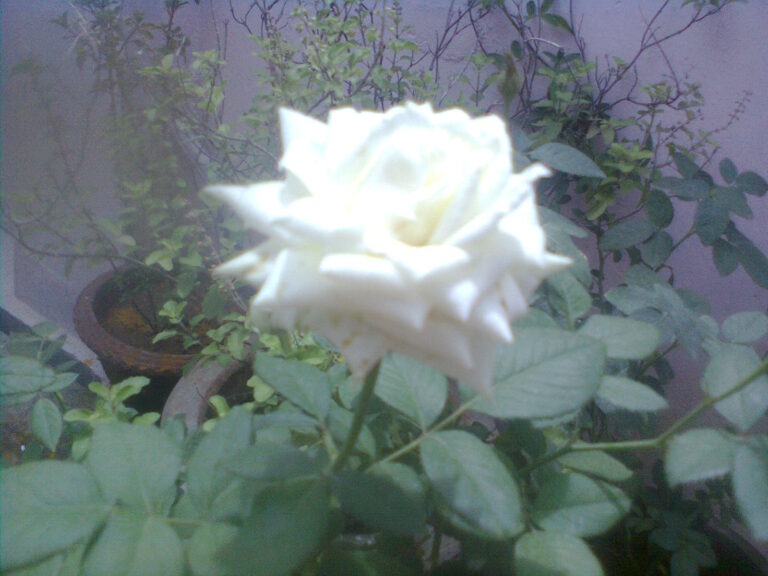
Overwatering, Wrong Potting Mix, and Poor Drainage – The Enemies of Flowering Plants
One of the biggest mistakes I made when growing flowers in pots was overwatering. It invited soil-borne fungal diseases, root rot, and pest attacks. I lost many beautiful flowering plants because the soggy soil created the perfect conditions for pathogens to thrive.
But let’s not forget—underwatering isn’t any better. It wilts the plant, makes it weak, and stunts its growth. Flowering plants need consistently moist (but not soggy) soil to survive and thrive. That fine balance in watering practices for flowering plants is a key to long-term success.
To make things worse, I was using the wrong potting mix—a heavy, compact, non-aerated garden soil without proper drainage. That only made overwatering more fatal. And don’t even talk about using expensive potting mix that lacks nutrition. If your potting mix isn’t well-draining or doesn’t have organic components and pest-preventive materials, your flowers are at serious risk.
The right potting mix matters so much. A well-aerated, sterile, organic-rich mix with additions like neem cake powder not only improves drainage but also protects plants from pests and fungal infections. Flowering plants aren’t as hungry as vegetables, but they do need more than what foliage plants demand. They need a balanced, nutrient-rich potting mix for potted flowers.
Also, drainage is non-negotiable, especially for flowering plants. Your containers must have drainage holes. Stagnant water and soggy soil suffocate the roots and open the door to fungal root infections. One simple drainage oversight can cost your entire plant.
Falling for Pinterest-Perfect Garden Images
I’ve been there too—completely mesmerised by those vibrant, manicured Pinterest flower gardens. But let’s be honest: real container flower gardens are often raw, messy, and evolving—and that’s their real beauty.
Flower plants in containers are naturally charming, especially when combined with simple flower care routines like deadheading, pruning, and proper sunlight placement. Even if your plant has a few scorched leaves, yellow edges, or natural leaf shedding, that’s okay! It’s all part of the plant’s lifecycle.
Focusing on a picture-perfect garden can lead to disappointment and neglect of actual plant health. Focus instead on building a healthy, low-maintenance flower garden, not a Pinterest fantasy. Healthy plants = beautiful plants, no matter how imperfect they look.
What I Wish I Knew When I Started
Here are a few things I wish someone had told me before I began my flower journey in pots:
Don’t use non-sterilized garden soil—it brings pests, diseases, and compaction. If you do use it, make sure it’s sterilised and mixed with organic materials like compost and cocopeat.
Avoid synthetic fertilizers for flowering plants. They might give you a burst of blooms, but at the cost of burning your plants. Organic slow-release fertilisers work better in the long run.
Mindful watering is a must. No fixed watering schedule works for all—do a finger soil test and water only when needed.
Place flower pots in their recommended sunlight exposure to support photosynthesis and flowering.
Use slow-release organic fertilizers based on the plant’s growth stage to boost flowering.
Regularly prune, pinch, and deadhead to maintain health and encourage fresh blooms.
Inspect regularly for early signs of pests or fungal issues to avoid infestations.
Lesson: Real flower gardens are imperfect, evolving, and still incredibly beautiful.
👉 Read my full blog on the biggest tool regrets after 7 years of container gardening to avoid the same mistakes and find smarter, budget-friendly fixes.
🪴 The Right Containers for the Right Flowers
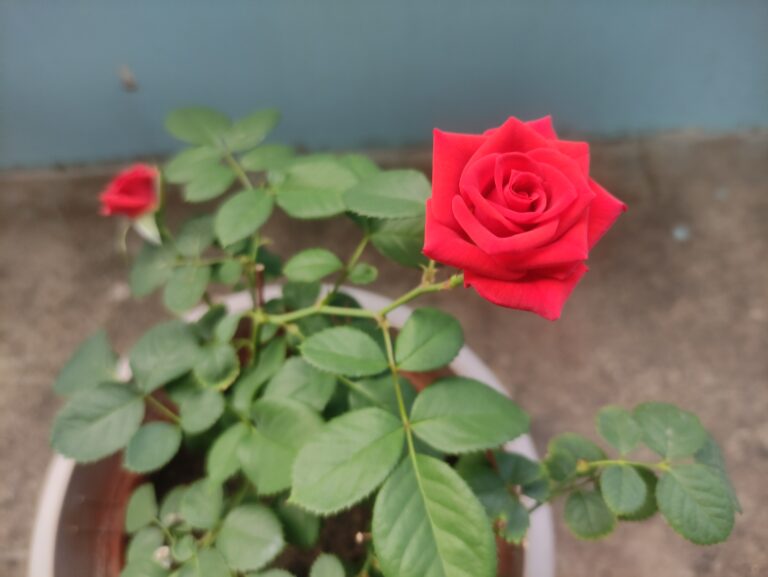
My Experience with Different Pot Materials for Flower Gardening
I’ve got plenty of hands-on experience growing flowers in pots using all kinds of materials. In my early gardening days, everything was done in ground beds. It was only later that I fully embraced container gardening on my terrace. Along the way, I’ve tested flower pots made of concrete, terracotta, plastic, and more—each one with its own pros and cons.
Concrete Pots: Heavy but Reliable for Native Varieties
Back when I started, I grew flowering plants in concrete pots. They’re strong, long-lasting, and did really well with native flowers. But they’re heavy—seriously heavy—and not something you can move around easily. So once placed, it’s better to leave them as is.
Terracotta Pots: My Favourite for Airy, Healthy Roots
In 2017–18, I shifted to terracotta pots for flowering plants, and I’ll be honest—they did great. These pots are naturally breathable, allow good air circulation, and there’s no major issue of waterlogging if you have the right drainage.
But terracotta isn’t perfect. Some pots are fragile and prone to breakage. They’re also heavy and tough to move, especially when filled. Plus, in humid weather, algae and moss can form on the outside. And now, because of high demand, terracotta pots aren’t as budget-friendly or easy to find as they once were.
Plastic Pots: Lightweight and Budget-Friendly
By 2021, I had completely moved to plastic pots for my terrace garden. With proper drainage holes and a well-draining potting mix, plastic pots work well. But they tend to retain more moisture, so you have to be extra careful with your watering schedule.
That said, plastic pots offer huge benefits. They’re available in all sizes, very affordable, and easy to shift around as your plants grow. This helps you avoid issues like overwatering and overfertilizing. And because they’re light, you can move them based on seasonal and sunlight pattern changes, or even just for garden decor.
What Works Best in Hot, Sunny Indian Climate
Since most parts of India are hot and sunny—my area included, with 70–80% sunny days—I’ve had to find pots suitable for hot Indian weather.
Terracotta pots are excellent if you can handle the weight and cost. Their porous nature keeps roots cool and prevents water stagnation.
I avoid glass, metal, concrete, wood, and fibre pots. They heat up fast under the sun, are heavy, and lack aeration—making them a poor choice for flower plants in full sun.
My go-to choices are:
Terracotta pots (for aeration and root health)
Plastic pots with drainage holes
Ceramic pots (for aesthetics, only if used with an inner pot or double pot method)
Grow bags can also be used, but only if they’re sturdy and high quality. Cheap grow bags wear out quickly under direct sunlight and stress the plant when they collapse or shift.
If you choose plastic pots, make sure they are UV-resistant to withstand the Indian summer heat without becoming brittle.
My All-Time Budget-Friendly Pot Option
To this day, my most budget-friendly container option for flowering plants is the humble plastic pot.
I know it might sound anti-ecoist, but let’s be practical—plastic pots are widely available, affordable in all sizes, and allow even beginners to build a garden without burning a hole in the pocket. With a good potting mix and enough drainage holes, they’re perfectly fine for growing flowers in small spaces.
Yes, plastic pots are non-breathable. So it’s important to use a well-aerated potting mix with cocopeat or compost, avoid overwatering, and follow the golden rule—never
water if the topsoil is still moist.
👉 Want to know which pots actually make a difference? Read my guide on the 6 best pots for container gardening and discover tried-and-tested tips.
🌞 Sun, Water, and Location: Microclimate Matters
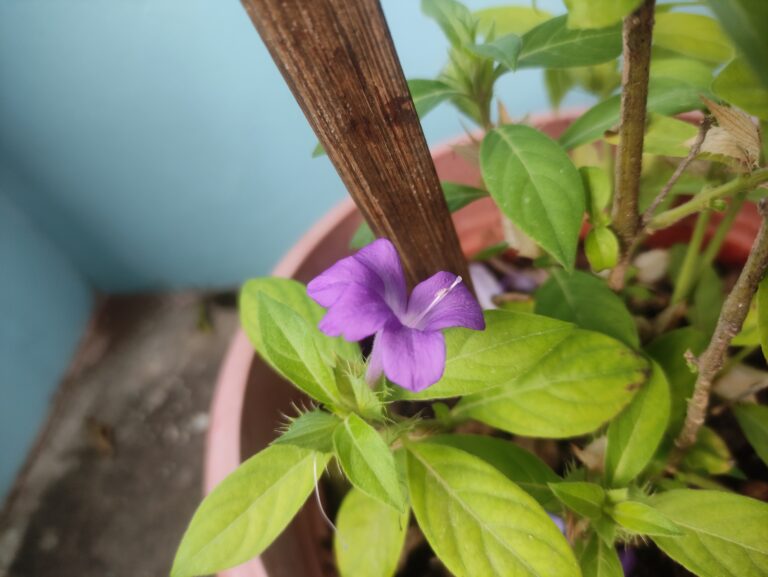
Understanding Microclimate for Healthy Flower Growth
Microclimate simply means creating the right growing environment for your plants by giving them the correct amount of sunlight, water, and space. For flowering plants in pots, this becomes even more important.
Flowers Need Sunlight, Not Shade
Flowering plants are not shade-lovers. They need sunlight to bloom well and stay healthy. Of course, every plant has its sunlight requirement, but placing sun-loving flowers in low light causes stunted growth, weak stems, and makes them more vulnerable to pests and diseases.
How I Understood the Sun Patterns on My Terrace
To truly know your garden’s light patterns, observation is key. I spent time monitoring my terrace garden’s sunlight pattern for a full year—yes, taking notes and photos from sunrise to sunset every hour. It might sound like a lot, but it’s the best way to learn.
Tracking the sunlight exposure for potted plants helps you reposition them seasonally so they continue getting the light they need all year. Your phone camera and a small diary are enough to start.
Grouping Sun-Loving vs Partial Shade Flowers
Grouping plants with similar light requirements in one area makes gardening easier. Not only do they thrive without sunburn or wilting, but it also helps with consistent watering and care.
“Not sure where to place your pots? Master sunlight, space, and drainage tips to help your container garden thrive—straight from real experience. Read here!“
Sun-Loving Flowering Plants for Pots:
Plant Name | Type | Bloom Colors | Notes |
Zinnia | Annual | Red, pink, orange, white | Heat-tolerant, continuous bloomer |
Portulaca (Moss Rose) | Annual | Bright mix, pink, yellow | Succulent, drought-tolerant |
Cosmos | Annual | Pink, white, orange | Airy look, attracts pollinators |
Sunflower | Annual | Yellow, orange, rust red | Tall grower, needs support |
Marigold (Tagetes) | Annual | Orange, yellow, gold | Pest-repellent, easy to grow |
Petunia | Annual | Many, including bi-colour | Great for hanging baskets |
Celosia | Annual | Red, yellow, pink | Flame-like flowers |
Lantana | Perennial | Multi-color clusters | Hardy, butterfly magnet |
Gaillardia | Perennial | Red-yellow blends | Wildflower looks, loves the sun |
Verbena | Perennial | Pink, purple, white | Trailing flower, perfect for edges |
Bougainvillea | Perennial | Purple, pink, orange, white | Loves heat, needs support |
Ixora | Perennial | Red, pink, yellow, orange | Compact, tropical, heat-lover |
Ruellia | Perennial | Purple, blue, pink | Drought-tolerant, bushy |
Hibiscus | Perennial | Red, yellow, pink, white | Showy flowers, loves warmth |
Chrysanthemum | Perennial | All shades | Winter bloomer, needs full sun |
Periwinkle (Vinca) | Perennial | Pink, white, purple | Thrives in full summer sun |
Partial Shade-Loving Flowering Plants for Pots:
Plant Name | Type | Bloom Colors | Notes |
Impatiens | Annual | Pink, white, red, lavender | Deep or filtered shade |
Torenia (Wishbone) | Annual | Purple, blue, pink | Great for humid, shaded areas |
Begonia | Annual | Red, pink, white | Glossy leaves, indirect light preferred |
Pansy | Annual | Purple, yellow, white | Cool-season blooms, mild shade |
Balsam (Gulmehendi) | Annual | Pink, red, purple | Fast-growing, shade-tolerant |
Peace Lily | Perennial | White | Best for shaded corners or indoors |
Anthurium | Perennial | Red, pink, white | Humidity-loving, semi-shade flower |
Hydrangea | Perennial | Blue, pink, white | Needs morning sun, moist soil |
Clerodendrum | Perennial | Red, white, pink | Semi-shade shrub |
Streptocarpus | Perennial | Purple, lavender | Great for low-light spots |
Oxalis | Perennial | Pink, white | Adds charm to small shaded containers |
Crossandra | Perennial | Orange, yellow, salmon | Tropical flower loves filtered sunlight |
Coleus (Foliage) | Perennial | Multicolor leaves | Grown for foliage, a shade-lover |
Watering Hacks for Scorching Summers and Dry Winds
During Indian summers, flower pots dry out quickly due to heat and wind. But remember—deep watering, not overwatering, is what plants need.
What is Deep Watering?
Deep watering means watering thoroughly in the early morning (6–7 AM) when the plant can absorb it slowly before evaporation kicks in. This helps reduce heat stress in potted flowers.
Use:
Drip irrigation for container plants
Self-watering pots
Watering spikes or globes
Bottom watering (if your plant count is manageable)
These methods help retain moisture without waterlogging the soil.
Preventing Heat Stress in Flower Plants
Mist the leaves occasionally on hot, non-watering days using a spray bottle.
Try the double pot method (placing a smaller pot inside a larger one) to reduce direct heat on the root zone.
Use shade nets in areas where sunlight is extremely harsh.
Add mulch for potted flowers—like coconut husk chips or dry leaves—to lock in moisture and cool the soil surface.
🌼 My Favourite Flowers That Thrive in Containers
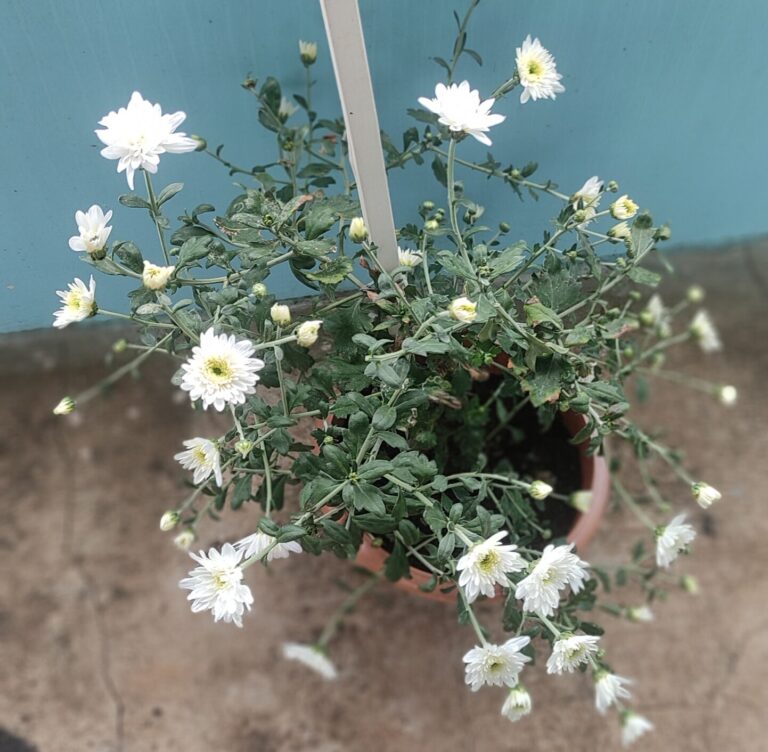
What I’ve Learned from Growing Different Flower Types in Pots
I grow plenty of flowering plants in pots—annuals, perennials, and native varieties. Sometimes, I even switch out annuals just to check if they can survive on my terrace garden. In my early days, I lost many of them to pest attacks, soil-borne diseases, underwatering, overwatering, or just pure forgetfulness.
But every plant I lost became a lesson.
Despite trying many varieties, there are a few I always go back to: simple roses, jasmines, and chrysanthemums. I never get tired of them. Even with so many color choices available, these three remain my all-time favorites.
Miniature roses are perfect for pots, but native rose varieties and tree-like types need larger containers or are best suited for ground beds. The same goes for jasmine—these are thick-rooted, deep-rooted plants that perform best in the ground. But if you don’t have space, just upgrade the pot size gradually to support healthy growth and better blooms.
Chrysanthemums, or mums, are the darlings of potted plants. Some last a few seasons, some complete their cycle in one. You can grow mums in pots from seeds or saplings easily.
Seasonal Flowering Plants That Work
Trying seasonal annual flowers or planting perennials during the right season can help keep your flower garden blooming all year round. A little planning based on plant type and local climate zone goes a long way.
You can’t control the weather, but you can pick flower plants suited to each season to help them survive and thrive. If you’re growing from seeds, start at least a month in advance. This way, the seedlings get ideal temperatures for early growth. For saplings, begin in the active growing season to ensure they establish quickly.
While schools may teach four seasons, for us gardeners, there are only three main planting seasons—Spring, Summer, and Fall. I usually avoid planting during winter dormancy, as it’s not ideal for active growth.

Pansies, violas, primroses, tulips, and snapdragons

Petunias, marigolds, zinnias, geraniums, begonias, sunflowers

Chrysanthemums, asters, celosia

After going full-time into gardening, I learned something valuable—you can’t give 100% every day. Life happens. Family events, sick days, unexpected work—all of it can interrupt your gardening flow.
So, the key is to keep the garden functional, even on your lazy or busy days, with low-maintenance flowering plants that thrive with minimal effort.
👉 Read my blog on budget-friendly tips to protect pots from heavy rain and keep your container garden safe this monsoon.
👉 Read my blog on post-monsoon plant care tips for container gardens to help your plants recover and thrive after the rains.
Here are some of my go-to easy-care flowers:
Marigolds (Tagetes): Super easy to grow, drought-tolerant, pest-repelling, and available in a wide range of affordable varieties online.
Zinnias: These fast-growing flowering annuals come in vibrant shades and attract pollinators like bees and butterflies.
Petunias: Low-maintenance blooms—saplings are easier to start with. No deadheading required, just sunlight and a good potting mix.
Begonias: Shade-tolerant and drought-resistant. Just water when the topsoil is dry. Their blooms keep going nonstop.
Portulaca: A succulent flower that thrives in heat, with colorful blooms and low water needs. Watch for occasional pests.
Lantana: Drought-tolerant and a butterfly magnet. Blooms all season long. Just give it well-draining soil and let it dry between watering.
Geranium: Loves the sun, drought-tolerant, and gives long-lasting blooms.
Vinca (Periwinkle): My tagline for this is plant and forget. I didn’t even plant it—the seeds came from the neighborhood and bloomed into a bush with 100+ flowers in three months. Heat-loving and disease-resistant, truly a gem!
What Failed & What Flourished?
Most of the flowering plants I mentioned above flourished well—some right away, some after a bit of trial and error. With the basics right—watering, choosing the right plants, using proper potting mix, early pest detection, and appropriate pot sizes—flowering success becomes easier.
Still, I’ve had stubborn plants that didn’t make it: Tube roses, dahlia, Ixora, barleria, and a few types of roses. But I don’t really see them as failures. It’s all part of the learning curve. Once you understand what your flower plants truly need, you’re halfway there.
Choosing flowers that suit your local climate solves at least 50% of the gardening issues. And if you’re trying a flower that isn’t naturally suited to your region, you’ll need to create a supportive microclimate—right sunlight, right pot, right soil.
My biggest villains? Overwatering, soil-borne diseases, and pest infestations. They can destroy flowering plants in no time if you’re not watchful.

Don’t use non-sterilized soil
Never reuse soil from disease-affected plants
Always ensure proper pot drainage
Avoid overwatering—test the soil before watering
Catch pest signs early and treat them quickly
🪴Soil Mix Secrets: What Worked for Me
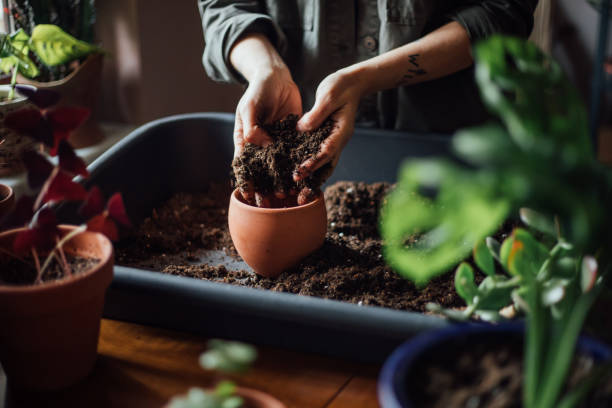
No “One Perfect Potting Mix” for Flowers
Let me be honest—there’s no such thing as a universal potting mix that works for all flowering plants. Even among flowers, some love rich organic matter, while others are sensitive to it. Some need moisture-retentive soil, while others demand quick drainage.
The best way? Choose flowering plants based on your local climate, then categorise them by their soil needs. This makes it easier to prepare custom potting mixes in bulk for 2–3 plants at a time—saving both time and effort.
And don’t forget the golden rule: every good potting mix needs proper drainage.
My Customised Soil Mixes for Different Flower Types
1. Cocopeat
2. Compost
3. Manure
4. Perlite
5. Vermiculite
6. Organic fertilizers
7. Neem cake
8. Peat Moss
9. Coconut husk chips (optional)

Seedlings need a light, sterile, and moisture-retentive mix. I always use a soilless potting mix for seed germination to avoid pathogens.
Seedling mix base:
50% cocopeat or 25% cocopeat + 25% peat moss
30% aeration (perlite or vermiculite)
20% organic matter (compost + aged manure)
Optional: a dash of organic nitrogen-rich fertilizer or homemade liquid feed
This promotes quick sprouting without the risk of damping-off disease.
For Common Flowering Plants in Containers
For popular potted flowers like mums, marigolds, petunias, vinca, zinnias, and impatiens, I use this balanced mix:
40% cocopeat or 20% cocopeat + 20% peat moss
20% aeration (perlite or vermiculite)
20% organic compost or manure
10% organic fertilizer blend (neem cake + bone meal + mustard cake powder)
It works great as an all-purpose flowering potting mix for Indian climates.
For Drought-Tolerant, Sun-Loving Flowering Plants
Flowers like portulaca, lavender, sedum, and gaillardia need dry, fast-draining soil. Moist soil will harm them.
Dry soil mix recipe:
20% cocopeat or peat moss
30% sterilized garden soil
20% aeration (pumice, perlite, or vermiculite)
10% coarse sand or poultry grit
10% organic matter
This is my go-to potting mix for drought-tolerant flowers that thrive in heat.
For Acid-Loving Flowering Plants
Hydrangea, azaleas, camellias, and gardenias prefer acidic soil. You’ll need to include acidic soil amendments—but only for these plant types.
Acidic potting mix:
30% peat moss
20% cocopeat
10% perlite or vermiculite
10% pine bark or coconut husk chips
5% compost or aged manure
5% powdered sulfur
A small tweak in soil pH can make a big difference for these bloomers.
For Moisture-Loving Flowering Plants
Some flowers need moist soil but also good drainage. Here’s the moisture-retaining potting mix I use:
30% sterilized garden soil
20% cocopeat
30% compost or organic matter
20% perlite or vermiculite
This blend holds water while avoiding sogginess.
For Chunky Soil Mix (Orchids, Indoor Flowers)
Orchids and indoor flowering houseplants prefer an airy, chunky, and semi-organic medium. I use this soilless orchid mix:
30% cocopeat
30% perlite or vermiculite
20% organic matter (manure or compost)
20% sterilized garden soil
This promotes aeration while still holding some moisture for tropical flowers.
🌾 Organic Amendments I Swear By (And What Didn’t Work)

Some organic potting amendments I still swear by are vermicompost and well-aged manure. These aren’t just plant foods—they actually improve soil texture, drainage, and aeration, making them great additions for flowering plants in pots.
But here’s the truth: timing and quantity make or break it. Even organic amendments can harm your plants when overused.
Overfeeding leads to pH imbalance, excess microbial activity, and even slug infestations.
Too much nitrogen causes lush green growth with no flowers, making the plant more prone to pests.
Using wet, soggy organic matter encourages fungal infections, while bone-dry amendments often lack nutrients.
The best practice? Always apply amendments that are moist—but not soggy.
One of my non-negotiables is:
Neem cake powder—it’s a must in all my potting mixes. It helps prevent both pests and soil-borne diseases. Truly a game-changer for flowering plants in containers.
What I Avoid in My Flower Garden Soil Mix
Unprocessed kitchen compost
Meat or dairy waste in compost piles
Fresh manure or unaged organic waste
Reusing disease-affected soil
Instead, I always use sterilized garden soil and well-composted organic matter to avoid root rot, fungal diseases, and pest infestations in my potted flowering plants.
Pests, Diseases & My Realistic Solutions:
Real Encounters with Mealybugs, Aphids & Fungal Leaf Spots
I’ve lost more than a few chrysanthemums to root rot and fungal infections—usually triggered by overwatering. And yes, I learned the hard way.
I also saw mealybugs infestations after forgetting to deadhead spent blooms. It turned my flowering pots into a mess.
And with plants like ixora and gardenia, I faced aphid attacks—which were triggered by excess organic feeding and missing the early signs of pests.
Since then, I’ve learned to take preventive steps and not rely solely on fancy sprays.
No Fancy Sprays—Just Real Remedies That Work
The fancy pesticide sprays on the shelf may give quick results, but in the long run, they build up harmful residues, damage the soil pH, and sometimes even burn the plant leaves.
Instead of overusing chemical pesticides or fungicides, I now follow a pest-free flower garden routine that’s simple, effective, and natural:
Always start with sterilized soil, never reuse infected soil.
Use only well-aged manure and compost—not fresh.
Give plants breathing space—avoid overcrowding pots.
Stay on top of deadheading and pinching to keep blooms healthy.
Add neem cake powder in the soil and use neem oil foliar spray weekly.
Follow deep watering methods—don’t over or underwater your flower pots.
Use well-draining potting mix for all flowering plants.
If a pest problem is serious, use a target-specific organic pesticide—not an all-in-one chemical.
Isolate infected plants immediately to prevent spread.
Attract and encourage beneficial insects (like ladybugs) by avoiding chemical sprays and fertilizers.
Curious about safe ways to keep pests away? Read my natural pest control tips for container gardening here.
Worried about your plants? Learn how to spot early signs of potted plant diseases before they spread.
🌺 Lessons Learned: Breaking the Myth of a “Perfect Garden”
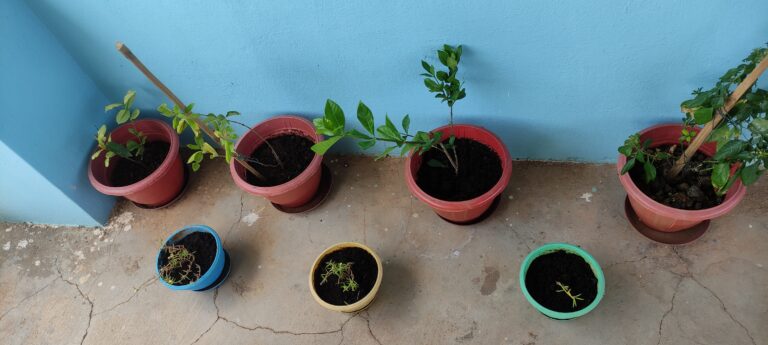
Why Failure is Part of Gardening
If there’s one universal truth I’ve learned through these years of growing flowers in pots—failure is part of real gardening. You can give everything your best—good soil, proper watering, sunlight—and yet, a plant might still wilt, rot, or never bloom.
But here’s the lesson: those failures are not wasted efforts. Each dead plant, pest infestation, or stunted bloom taught me how to tweak the next planting. The best part? Your garden becomes a reflection of your learning, not perfection.
Real gardens aren’t flawless—they’re evolving stories told by petals, leaves, and a few fallen flowers.
The Joy of One Bloom vs a Full Instagram-Worthy Pot
It’s tempting to aim for those Pinterest-perfect flower pots—lush, colorful, overflowing with blooms. But the truth is, the first flower after weeks of care brings more joy than any staged photo.
Container gardening isn’t a competition. It’s a slow, rewarding practice where one marigold bloom can feel like a personal victory.
So if your flowering pot looks a little sparse, uneven, or slightly sunburned—celebrate it. It means your plant is trying, just like you are.
Letting Go of Guilt: It’s Okay if a Plant Dies
There were times I felt guilty for losing a plant, especially when I’d put in days of care. But over time, I’ve learned that even the most seasoned gardeners lose plants.
Potted flowering plants are vulnerable to many things—weather, soil conditions, pests, and sunlight shifts. A plant dying doesn’t mean you failed. It simply means something didn’t work, and now you know what to do differently.
Let go of the guilt, keep the pot, and try again. Every plant loss becomes a seed of new knowledge.
Celebrating Progress Over Perfection
Gardening on a terrace with containers is full of limitations—space, sunlight, pot material, pests. But it also teaches you something very important: progress is everything.
A single bud after months of leaf care
Saving a plant from pest attack
Repotting a stressed flower into fresh soil
Learning when to water, and when not to
These small wins matter more than a picture-perfect bloom.
Your flower garden doesn’t need to impress anyone—it needs to bring you peace, purpose, and joy. Let it be messy, imperfect, and still beautiful.
❤️ Final Thoughts: Flowers, Patience, and Joy
What Flowers Taught Me About Life and Patience
Growing flowers in pots has done more than just brighten up my terrace—it’s taught me patience, mindfulness, and the joy of slow progress. From waiting for the first sprout to watching a single bud open after weeks of care, each step has become a gentle reminder that good things take time.
Flowers don’t bloom overnight. Neither do we.
Why I’ll Continue Growing Flowers—No Matter the Space or Age
Whether it’s a single terracotta pot in a balcony corner, a row of plastic planters under sunlight, or a repurposed grow bag on a windowsill, I know I’ll keep growing flowers as long as I can.
You don’t need a big garden or perfect setup. Just a little space, a little love, and the willingness to learn as you go.
Gardening isn’t about your age or resources—it’s about finding joy in small, blooming moments.
To Beginners: Start With One Pot
If you’re new to flower gardening and overwhelmed by perfect Pinterest images or long plant lists, here’s my advice:

Pick a beginner-friendly flower, give it good soil, the right pot, enough sun, and your attention. That’s all.
You’ll be surprised how one flower can change your space—and your mood.
Share Your Journey
Have you just started growing flowers? Did a plant teach you something? Or maybe you’ve had your own trial-and-error gardening journey like mine?
I’d love to hear from you! Drop a comment and share your flower garden wins, lessons, or questions. Let’s grow together




Sunlight, Space & Drainage Guide – The three essentials every flower pot needs

Pingback: Top 3 Essentials for Container Gardening Success: Sunlight, Space & Drainage Explained
Pingback: Overgrown Pots? 7 Easy Pruning Lessons for Healthy Plants